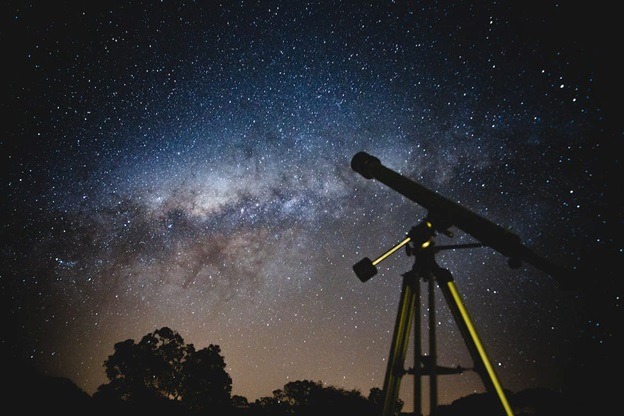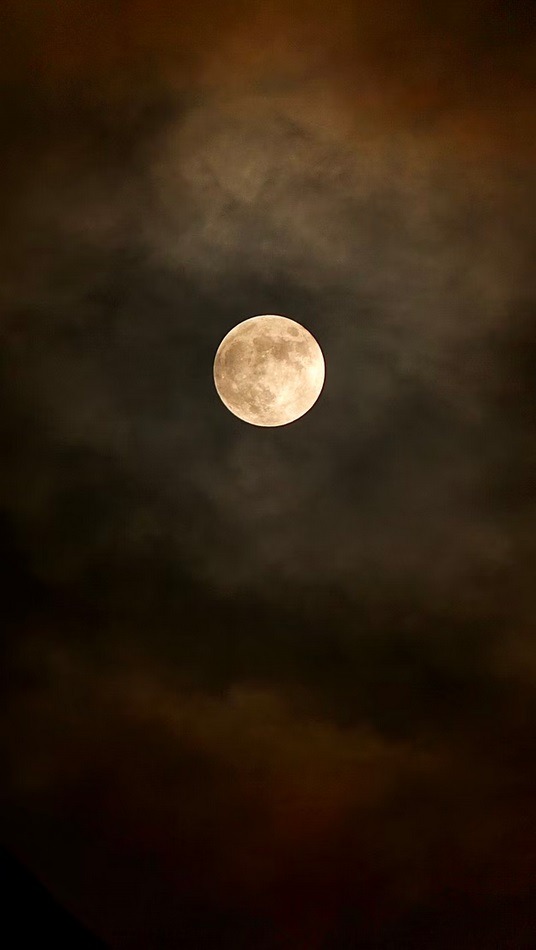Why Is Io the Most Volcanic Moon?
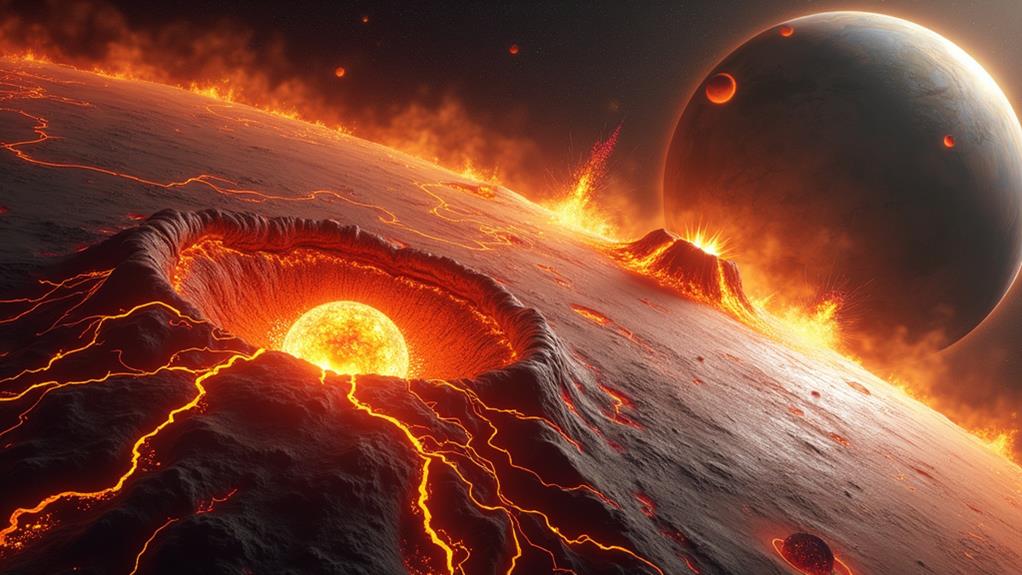
Io is the most volcanic moon because of intense tidal heating caused by gravitational interactions with Jupiter and neighboring moons. This constant tug-of-war generates immense internal heat, leading to continuous volcanic eruptions. Io's volcanic activity is powered by a mix of a solid inner core and a molten outer core, driving magma to the surface. The regular flexing from its eccentric orbit results in dynamic geological changes, with around 400 active volcanoes reshaping the landscape. This extreme environment creates a constantly changing surface, showcasing breathtaking volcanic features. Uncover more about what makes Io so distinctively explosive.
Key Takeaways
- Tidal heating from gravitational interactions generates significant internal heat, fueling intense volcanic activity.
- Io experiences surface bulges up to 330 feet due to gravitational forces from Jupiter and neighboring moons.
- Continuous internal flexing from its elliptical orbit leads to dynamic geological processes and frequent eruptions.
- Io's mantle of silicate rock and molten iron-sulfide core drive volcanic activity.
- Active volcanoes and sulfur-rich surface compositions result in a young, constantly renewing landscape.
Discovery and Naming
Galileo Galilei identified Io on January 8, 1610, making it the initial moon found orbiting a planet other than Earth. This groundbreaking revelation of one of Jupiter's moons marked a critical moment in astronomy. Initially dubbed Jupiter I, Io wasn't just another celestial body; it was an essential piece of evidence supporting the heliocentric model of the solar system. Alongside Europa, Ganymede, and Callisto, Io became one of the four Galilean moons, collectively named in honor of their discoverer.
The naming scheme for these moons took inspiration from Greek mythology. Io, in particular, was named after a priestess of Hera, reflecting the tradition of naming celestial bodies after mythological figures. Simon Marius suggested these names, and they were officially adopted in the mid-1800s to avoid confusion from the earlier numerical designations.
Io's revelation and its subsequent naming were not just astronomical milestones but also cultural ones, merging scientific achievement with mythological heritage. These moons' orbital patterns around Jupiter provided essential insights into planetary motion, cementing Galileo's findings as foundational in our understanding of celestial mechanics. Consequently, Io's revelation greatly advanced both scientific knowledge and cultural enrichment.
Physical Characteristics
Revealing its unique geological makeup, Io stands out as the most volcanically active body in our solar system. When you examine Io, you'll see a moon slightly larger than Earth's Moon, with a mean radius of 1,131.7 miles (1,821.3 km). This size plays a significant role in its intense geological activity.
Io's volcanic activity is driven by extreme tidal heating. As Io orbits Jupiter in an elliptical path, the immense gravitational pull from the giant planet and its neighboring moons causes substantial tidal forces. These forces create surface bulges of up to 330 feet (100 meters), generating heat that fuels the moon's dramatic volcanic eruptions.
Despite an average surface temperature of around -130°C (-202°F), Io's volcanic eruptions can reach scorching temperatures exceeding 1,000°C (1,832°F). This stark contrast is a demonstration of the incredible energy produced by tidal heating.
The surface of Io is primarily composed of sulfur and sulfur dioxide. These elements not only contribute to its lively, colorful appearance but also to its relentless geological activity. With 20 times more heat flow than Earth, Io's dynamic landscape is constantly reshaped by its powerful volcanic forces.
Internal Structure
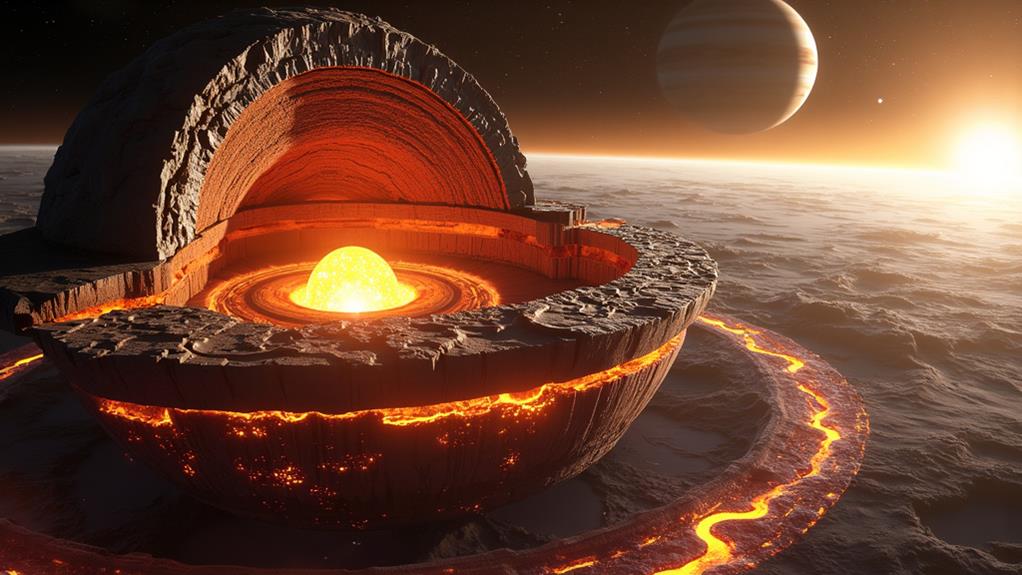
Understanding Io's internal structure is crucial to grasping the moon's extraordinary volcanic activity. At its core, Io consists of a solid iron inner core, surrounded by a molten iron-sulfide outer core. This is encased in a mantle made primarily of silicate rock. You can think of this internal structure as the engine driving Io's intense volcanism.
Io's volcanic activity is mainly powered by tidal heating. As Io orbits Jupiter in an eccentric orbit, the gravitational pull from Jupiter, along with the interactions with its neighboring moons, Europa and Ganymede, create immense tidal forces. These forces stretch and squeeze Io, generating significant internal heat. This heat flow is estimated to be about 20 times greater than Earth's, keeping Io's mantle partially molten.
Tidal forces and the resulting heat flow cause dynamic geological processes within Io. The molten lava and sulfurous materials beneath its surface frequently erupt, leading to continuous volcanic activity. These geological processes are a direct result of the constant internal flexing, making Io the most volcanically active body in our solar system. Understanding this internal structure helps you appreciate the underlying mechanisms driving its relentless volcanic eruptions.
Surface Features
Building on our knowledge of Io's internal structure, we can now investigate its remarkable surface features. Io's surface is a demonstration of its intense volcanic activity, with hundreds of active volcanoes creating a landscape like no other in the Solar System. The tidal heating driven by gravitational interactions with Jupiter and neighboring moons generates immense internal heat. This heat causes the melting of materials that surface as lava flows, some of which can reach temperatures exceeding 1,000°C (1,832°F).
Io's dynamic landscape is constantly being reshaped. Extensive plains of sulfur and sulfur dioxide cover its surface, which is young and smooth, marked by a surprising lack of impact craters. This absence suggests that geological processes are continuously renewing Io's surface, making it only a few million years old. Another fascinating aspect of Io's surface features is the chaos terrain, resembling jumbled textures similar to icebergs in a frozen sea. These areas highlight the moon's unique geological activity and the constant movement of crustal materials.
Volcanic Activity
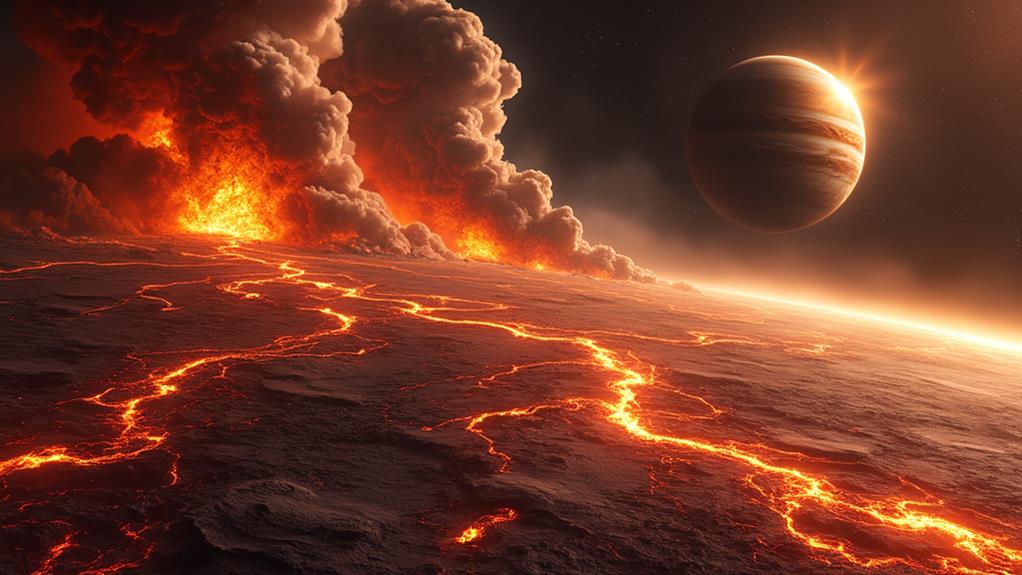
Due to its extreme volcanic activity, Io stands out as the most volcanically active body in the Solar System. With over 400 active volcanoes, Io's surface is in a constant state of transformation. These volcanic eruptions can produce spectacular lava fountains that reach dozens of miles high, reshaping the landscape continuously. The primary cause of this activity is tidal heating, generated by Io's irregularly elliptical orbit around Jupiter. This orbit subjects Io to intense gravitational forces that create significant internal heat.
These gravitational forces result in gravitational stretching and squeezing, causing Io's surface to bulge up to 330 feet (100 meters). This intense internal heat flow, approximately 20 times greater than Earth's, powers the moon's numerous active volcanoes. Lava temperatures on Io can exceed 1,000°C (1,832°F), filling impact craters with molten material and renewing the surface.
Observations from the Galileo spacecraft have shown that volcanic eruptions on Io are quite different from those on Earth. The unique internal heating mechanisms and lack of stable environments on Io contribute to these differences, making the moon's volcanic activity unparalleled in its ferocity and scale.
Tidal Heating
How does Io manage to sustain such extraordinary volcanic activity? The answer lies in the phenomenon of tidal heating. Io experiences extreme tidal heating due to its irregularly elliptical orbit, which subjects it to varying gravitational forces from Jupiter and its neighboring moons. These powerful gravitational forces cause the moon's surface to bulge up to 330 feet (100 meters). This constant flexing generates significant internal heat, a process known as internal heat generation.
The tidal forces on Io are roughly 1,000 times stronger than those on Earth's Moon, leading to intense volcanic activity. This tidal heating produces about 20 times more heat flow than what we see on Earth, making it a primary driver of Io's volcanic activity. The energy from tidal heating is estimated to be 100 times greater than that from radiogenic sources, facilitating the formation of magma beneath Io's surface.
Because of this extreme tidal heating, Io boasts over 400 active volcanoes, earning it the title of the most volcanically active body in the Solar System. The continuous magma formation and volcanic eruptions are direct results of the immense internal heat generated by these relentless tidal forces.
Orbit and Rotation
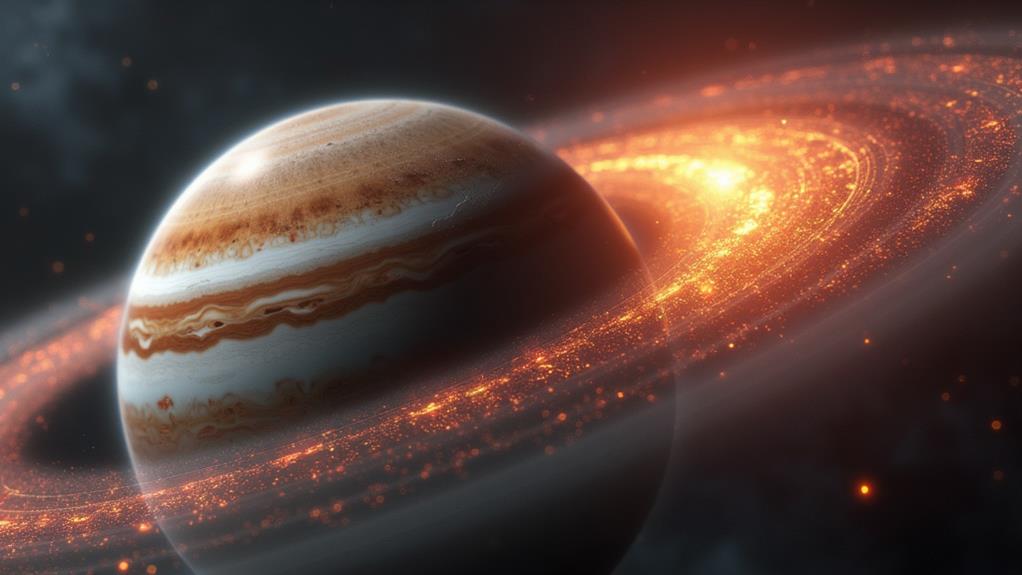
Io's orbit around Jupiter is a fascinating dance that occurs every 1.8 Earth days, making it the innermost of the four Galilean moons. As Io orbits, it experiences a strong gravitational pull from Jupiter, in addition to from its neighboring moons, Europa and Ganymede. This gravitational interaction creates significant tidal forces that cause Io's surface to bulge by up to 330 feet (100 meters). These surface bulges lead to immense internal heating, which drives the moon's prolific volcanic activity.
Io's orbit isn't a perfect circle; it's highly eccentric. This irregular orbit amplifies the tidal forces, continuously flexing Io's interior and contributing to its intense volcanic eruptions. Adding to this intriguing scenario, Io is tidally locked to Jupiter, exhibiting synchronous rotation. This means that Io always shows the same face to Jupiter, much like our Moon does to Earth.
These tidal forces, combined with Io's eccentric orbit and synchronous rotation, create a dynamic environment beneath Io's surface. The relentless gravitational tugging from Jupiter and the other Galilean moons guarantees that Io remains the most volcanically active body in our solar system, perpetually reshaping its landscape.
Exploration Missions
Exploration of Io began with early missions like Pioneer 10 in 1973 and Pioneer 11 in 1974, which provided the initial glimpses of this volcanic moon's surface. These missions gave us the primary data on Io's environment and hinted at its dynamic nature. However, it wasn't until Voyager 1 and 2 flybys in 1979 that Io's true nature was revealed. Capturing stunning images, the Voyagers provided the initial evidence of Io's intense volcanic activity, showing that active volcanism existed beyond Earth.
The Galileo spacecraft, which orbited Jupiter from 1995 to 2003, took our understanding even further. It documented hundreds of volcanoes and demonstrated how tidal heating from Jupiter's gravitational pull fuels Io's volcanic processes. Galileo's detailed studies highlighted how these forces shape Io's geology, making it the most volcanic body in the solar system.
More recently, Juno's close flyby in December 2022 enriched our knowledge by studying Io's interaction with Jupiter's magnetic field and its ongoing geological activity. Looking ahead, the European Space Agency's JUICE mission, launching in April 2023, aims to explore deeper into Io's volcanic processes and its role within the Jovian system. Through these exploration missions, we've uncovered Io's fiery secrets and its complex relationship with Jupiter.
Geological Impact
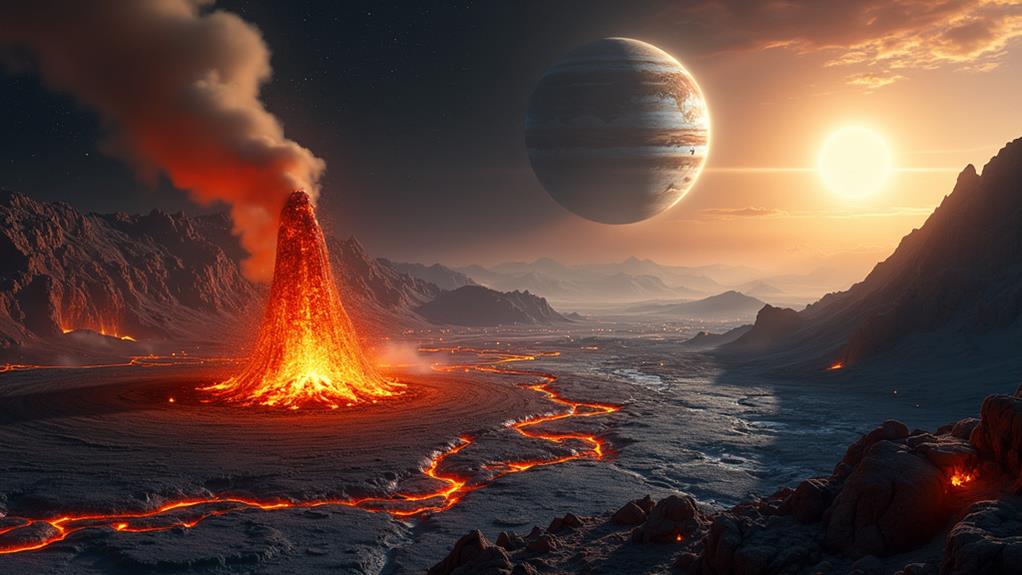
Volcanic activity on Io leaves an indelible mark on its landscape, making it one of the most fascinating celestial bodies in our Solar System. Io's extreme volcanic activity, driven by tidal heating, shapes its unique geological features. The gravitational interactions with Jupiter and neighboring moons generate immense heat flow, 20 times greater than Earth's, causing significant tidal flexing. This flexing results in surface bulges up to 330 feet (100 meters), fueling the moon's geological dynamism.
Io's elliptical orbit leads to varying gravitational forces that create internal friction and heat. This constant internal friction is a key contributor to the moon's remarkable volcanic activity. With around 400 active volcanoes, some of which erupt lava exceeding 1,000°C (1,832°F), Io continuously renews its surface, filling impact craters with fresh lava. These active volcanoes are not only spectacular but also critical in shaping Io's ever-changing landscape.
The moon's surface is adorned with striking geological features like lava lakes and extensive sulfur deposits, indicating ongoing volcanic processes. These elements highlight Io's status as an extraordinarily dynamic celestial body, with its geological impact underscored by relentless volcanic activity and the effects of tidal heating.
Astrobiological Implications
When considering the astrobiological implications of Io, it is crucial to acknowledge the moon's extreme volcanic activity driven by tidal heating from Jupiter and its neighboring moons. This intense volcanic activity creates extreme environments that pose significant challenges for the potential for life. The presence of sulfur compounds and volcanic materials on Io suggests a harsh and inhospitable environment, making it less likely to support life compared to other celestial bodies, like Europa, which have subsurface oceans.
The intense radiation and lack of stable environments on Io further diminish the chances for any form of life to emerge or survive in its volcanic landscape. Despite these extreme conditions, studying Io's geology and volcanism can provide valuable insights into the geothermal processes that shape other celestial bodies. Understanding these processes helps scientists comprehend the potential for life in more favorable environments elsewhere in the Solar System.
Io's chaotic environment and volcanic activity highlight the complexities of astrobiological potential. This emphasizes the need to investigate moons with more favorable conditions, such as Europa, where the presence of liquid water and less extreme conditions offer better prospects for astrobiological studies.
Frequently Asked Questions
Why Is the Io More Volcanically Active Than Our Moon?
Io's geology is shaped by tidal heating from Jupiter's gravity, unlike our Moon's stable environment. These forces cause volcanic eruptions, producing sulfur dioxide and unique magma composition. You'd see dynamic surface features and volcanic plumes, not found on our Moon. Io's internal structure, with molten sulfur and silicate, drives its intense volcanism. Comparative volcanism and extraterrestrial exploration reveal Io's constant surface renewal, contrasting our Moon's geological inactivity.
Why Does Io Have the Most Volcanic Activity?
You see, Io's extreme volcanic activity is due to powerful tidal forces and internal heating. These forces create friction that melts its interior, forming magma oceans. Io's sulfur dioxide-rich volcanic plumes and lava lakes constantly reshape its surface composition. Its orbital resonance with Europa and Ganymede amplifies these effects. As a result, Io retains heat, leading to frequent volcanic eruptions and making it the most volcanically active moon.
What Causes Io to Be so Volcanic?
Imagine Io as a cosmic pressure cooker. Tidal heating's the main culprit, caused by gravity interactions with Jupiter and neighboring moons. These tug-of-war forces affect Io's internal structure, generating intense heat, leading to magma generation. The moon's surface composition and geologic activity support volcanic plumes. Orbital resonance keeps this cycle going, while Io's heat retention means it's always ready to erupt. Though cryovolcanism potential exists, it's overshadowed by constant volcanic activity.
Why Is Io Moon Special?
Io's moon is special because of Io's geology and intense volcanic eruptions driven by tidal heating. You'll find sulfur dioxide and a magma ocean beneath its surface, creating dramatic surface features and volcanic plumes. Its thermal activity offers unique insights into planetary formation. While searching for extraterrestrial life, Io's extreme environment challenges our understanding of habitability. The continuous volcanic activity keeps Io's landscape ever-changing and fascinating to study.



